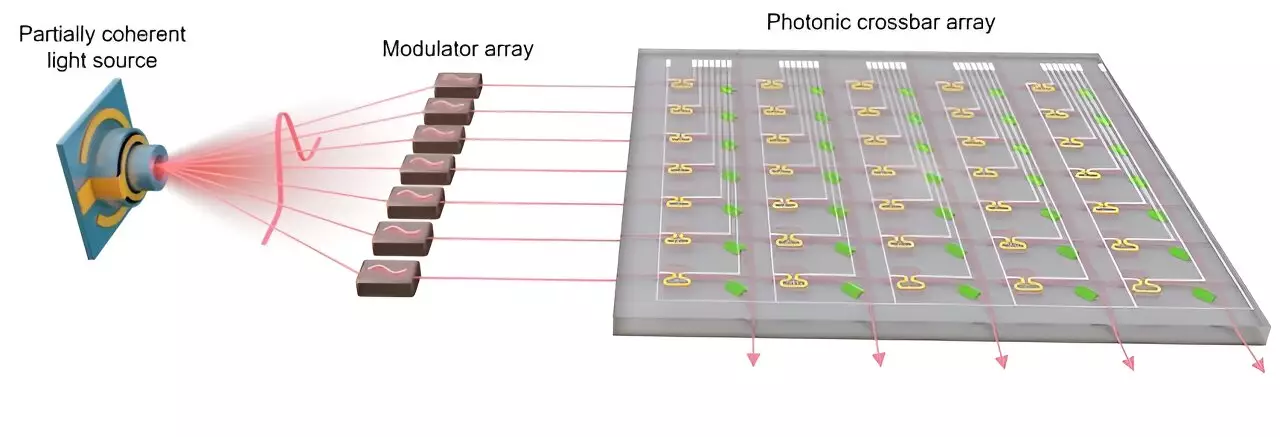The landscape of optical communication and computing is undergoing a transformative evolution, guided by innovative research from the University of Oxford and its international collaborators. In their groundbreaking study titled “Partial coherence enhances parallelized photonic computing,” the research teams challenge long-standing beliefs about light sources in technological applications. Traditional optical systems have heavily relied on high-quality, coherent lasers; however, this new research provides compelling evidence that low-coherence light sources can actually enhance performance in specific applications, notably artificial intelligence (AI).
This discovery shifts the focus from high-cost, energy-hungry lasers to simpler, less expensive light sources, such as incandescent bulbs and the sun, which emit a broader spectrum of wavelengths. The scientists have opened the door to more accessible and energy-efficient technologies that can potentially revolutionize how we think about photonic applications and computational speed.
The Coherence Conundrum
Coherence refers to the consistency of light waves in time and space, quantified as the ability of the light to maintain a fixed phase relationship. High coherence is typically associated with lasers that generate light at a narrow range of wavelengths, producing what we typically perceive as “pure” colors. These sources have been instrumental in various fields, including telecommunications, remote sensing, and medical imaging, creating a deeply entrenched assumption that coherence equates to performance.
However, the researchers found that in certain scenarios, such as photonic AI accelerators—where performance is crucial—low-coherence light sources might provide unexpected advantages. By utilizing partially coherent light, the team demonstrated extraordinary potential for enhancing parallelism in computational processes. They leveraged an electric-pumped erbium-doped fiber amplifier, typically used for boosting signals in optical communications, to generate a portion of incoherent light that was then split across various input channels.
Boosting AI Processing Capabilities
The implications of this technology are far-reaching. By employing a partially coherent light source, the team discovered an ability to scale AI operations dramatically. In experiments, the parallel processing capability of a photonic AI accelerator reached astonishing levels, processing data at speeds equivalent to running over two hours of 4K video in just one second, success only previously achievable with multiple coherent lasers.
This speed and efficiency leap is not merely a matter of augmenting capabilities; it could fundamentally reshape how we design and build AI systems. For instance, experiments pinpointing gait analysis for Parkinson’s disease patients resulted in a classification accuracy exceeding 92%. Such precision is not only a triumph for AI technology but a critical advancement for medical diagnostics, indicating how this innovative light source can translate into significant real-world applications.
Transformational Implications for Computing
The primary insight derived from this research is that the performance advantages of using simpler light sources are scalable. Dr. Bowei Dong, the study’s first author, emphasizes that adopting less intense light sources can enable an enhancement in operational speed—up to 100 times faster than conventional laser systems. This has profound implications about future developments in photonic systems, potentially making advanced computing capabilities available to a broader range of industries while reducing costs and energy consumption.
The leading researcher, Professor Harish Bhaskaran, has indicated that the use of partially coherent light may extend beyond AI into the realm of optical communications. With the rise of innovative optical interconnect technologies, the possibility of more versatile communication methods appears imminent. This transition could enable data transmission that is not only faster but also more efficient, adapting to the dynamic needs of future digital environments.
The Future of Photonic Technologies
As researchers continue to explore the applications of low-coherence light sources, the potential for reengineering existing optical frameworks becomes more evident. This insight encourages a reevaluation of the parameters guiding photonic computing, where the focus shifts from merely seeking coherence to understanding how leveraging diverse characteristics of light can yield extraordinary breakthroughs.
The dynamics of this research not only underscore the limitless possibilities within the realm of photonics but also highlight the critical need for innovative thinking in scientific inquiry. As we move forward, the implications of these findings may redefine the benchmarks for success in optical technologies—replacing the old guard with fresh, groundbreaking methodologies that prioritize performance and sustainability over conventional wisdom.


Leave a Reply